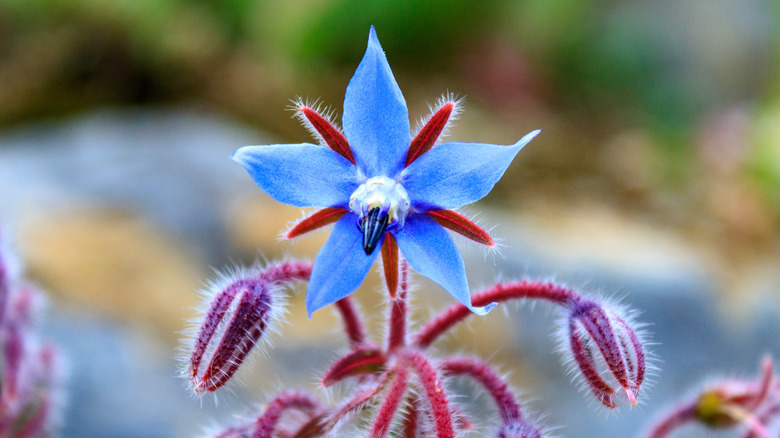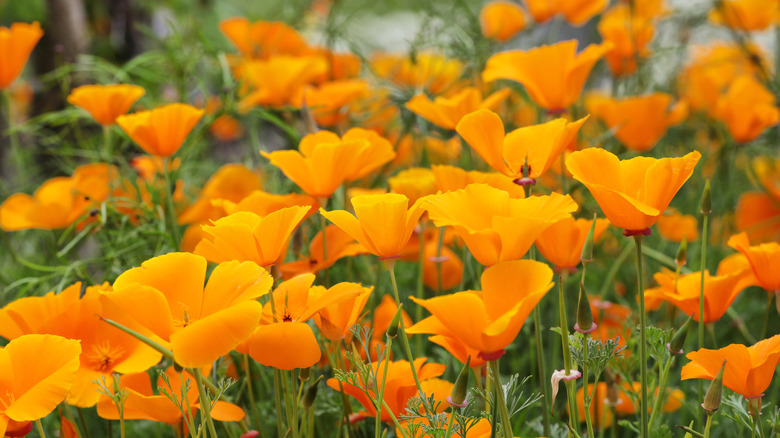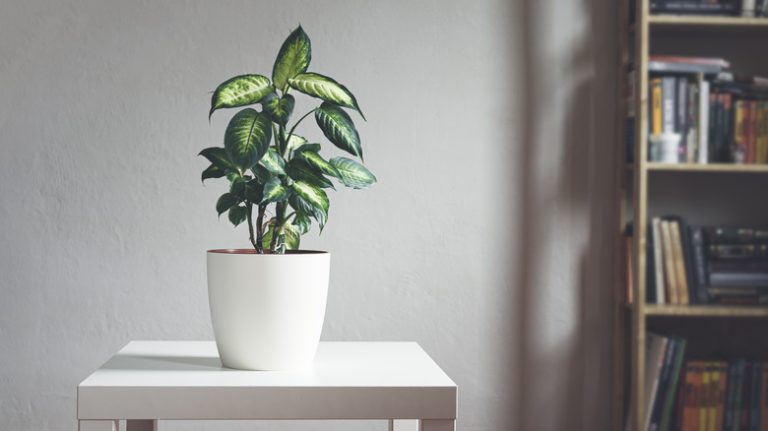To flower aficionados, not much sounds better than a backyard full of vibrant colors and blooms of all shapes and sizes. To those of us with thumbs in a slightly paler shade of green, it may still sound appealing, but also like a heck of a lot of work. That’s where the beauty of self-seeders (or self-sowers) comes in. These plants will not only save you time and money by replanting themselves each year, but they also tend to come back stronger and more pest-resistant (via HGTV).
However, note the practice of deadheading in the garden to extend a plant’s flowering season will interfere with its ability to self-seed. Blooming Backyard goes so far as to recommend deadheading in the event you want to prevent self-seeding. Another thing to consider is that, on occasion, prolific growers get categorized as weeds or invasive species. While these flowers will cover your backyard rather effortlessly, it could take quite a bit of resolve on your part if you changed your mind and wanted to get rid of them. Of course, it’s always worth doing a little research to ensure the varieties you pick out are native to the region.
All that said, don’t let a mild warning hold you back from letting your backyard grow wild with color and delight. Without further adieu, here are 15 flowers guaranteed to put a smile on your face every time you step outside.
Blue sea holly

To get started with a slow self-seeder, consider blue sea holly (Eryngium planum). Per NC State Cooperative Extension, these spiky, pale blue bloomers resist hungry deer and rabbits, making them a perfect addition to a border garden surrounding a vegetable patch. Blue sea holly will look nice planted with flowers of contrasting colors, like black-eyed Susans. It’s also a popular choice for dried floral arrangements.
Bloom Season: Summer
USDA Growing Zone: 5 to 9
Growing Conditions: Full sunlight
Soil Type: Dry silt or sand
Size: 2 to 3 feet high and 1 to 2 feet wide
Borage

Borage flowers (Borago officinalis) look like periwinkle blue starbursts. They tend to make quality companion plants because they attract beneficial pollinators while simultaneously repelling pests, according to the Agriculture and Natural Resources Department at the University of California. Borage is unfussy and will do just fine in nutrient-deficient soil. Plant it once and it will continue to self-seed year after year.
Bloom Season: Spring, summer, and fall
USDA Growing Zone: 2 to 11
Growing Conditions: Full sunlight
Soil Type: Tolerant of ranges
Size: Up to 3 feet tall and 2 feet wide
Calendula

Muhammad Shahzad arain/Shutterstock
Commonly referred to as marigolds, calendula (Calendula officinalis) flowers bring a welcome splash of yellow and orange sunshine to the garden — and they’ll do the same when left to self-seed throughout your yard. NC State Cooperative Extension notes these rabbit-resistant plants produce edible flowers that can spice up a salad or be used to create an all-natural yellow dye.
Bloom Season: Spring and summer
USDA Growing Zone: 2 to 11
Growing Conditions: Full sunlight to partial shade
Soil Type: Average, moderately fertile, well-draining
Size: 1 to 2 feet high and wide
California poppies

Alex Manders/Shutterstock
The delightfully bright and cheerful golden poppy (Eschscholzia californica) is the state flower of California. Per Calscape, poppy seed pods are designed by nature to burst themselves open. They’ll take care of their own reseeding needs, but you can also collect seeds and spread them to areas where you’d like to see more of these golden delights. Rabbits enjoy munching on poppies, but they are deer-resistant.
Bloom Season: Spring, summer, fall, and winter
USDA Growing Zone: 8 to 10
Growing Conditions: Full sunlight
Soil Type: Sandy, infertile, well-draining
Size: Up to 2 feet tall and wide
Columbine

Wut_Moppie/Shutterstock
The bell-shaped blossoms of the columbine plant (Aquilegia spp.) give it the funny nickname of granny’s bonnet. The Old Farmer’s Almanac states these blossoms will invite just about every type of pollinator to the garden party, including bees, butterflies, and moths. If you’re looking for flowers that will attract hummingbirds to your garden, this is definitely one to consider. Columbines self-seed and multiply at a very fast rate.
Bloom Season: Spring and summer
USDA Growing Zone: 3 to 9
Growing Conditions: Full sunlight to partial shade
Soil Type: Average, moderately fertile, well-draining
Size: 10 to 30 inches tall
Cosmos

Tonio_75/Shutterstock
For a backyard covered in colorful petals, you can’t go wrong with cosmos flowers (Cosmos spp.). These delicate blossoms come in a wide variety of colors, and HGTV notes that, aside from the chocolate cosmos, they all have yellow centers.
Bloom Season: Spring, summer, and fall
USDA Growing Zone: 2 to 11
Growing Conditions: Full sunlight, but they appreciate partial shade in excessive heat (via American Meadows)
Soil Type: Dry and arid
Size: Most popular plants are dwarf varieties, but some can reach up to 5 feet tall
Foxglove

Sopha Changaroon/Shutterstock
If you’re in the market for a single plant that can produce as many as two million seeds, then look no further than the common foxglove (Digitalis purpurea). According to the University of Madison-Wisconsin, the downward-facing tubular flowers are another hummingbird favorite. With everything from white, pink, yellow, and lavender blooms, you can really up the color factor of your yard with tall, showy foxgloves.
Bloom Season: Early summer
USDA Growing Zone: 4 to 9
Growing Conditions: Full sunlight to partial shade
Soil Type: Tolerant of a range
Size: Up to 4 feet tall
Globe amaranth

Dhujmontra/Shutterstock
Globe amaranth plants, known botanically as Gomphrena globosa, form in brightly colored clusters that will dazzle your yard with pink, red, or purple lollipops. You may even score a plant with orange-colored blossoms. According to Britannica, globe amaranth can be trusted to attract butterflies to your garden, as it blooms abundantly throughout the entire season.
Bloom Season: Summer and fall
USDA Growing Zone: 2 to 11
Growing Conditions: Full sunlight
Soil Type: Prefers moist soil, but can adapt to drier conditions over time
Size: 6 to 20 inches tall depending on the variety
Hollyhocks

Alex Manders/Shutterstock
Growing hollyhocks (Alcea rosea) guarantees color and pizazz will be in full force. Britannica notes that hollyhocks are deemed invasive outside of their native regions, but with up to 9 feet of majestic height, they’re truly desirable, no matter where you live. Space initial plantings as much as 18 inches apart to create room for the crop that will grow next season after seeds are dropped (via SD State University Extension).
Bloom Season: Summer and fall
USDA Growing Zone: 3 to 8
Growing Conditions: Full sunlight
Soil Type: Tolerant of a range
Size: 6 feet or taller
Love-in-a-mist

billysfam/Shutterstock
Delicate and wispy with an old-timey vibe, love-in-a-mist flowers (Nigella damascena) have thin green bracts (a.k.a. the mist) surrounding each blossom. The University of Madison-Wisconsin recommends planting them alongside strawflowers, bachelor buttons, and the aforementioned globe amaranth. Your flowers will most likely pop out of the ground in shades of blue, but you may see some whites, pinks, and lavenders in there, too.
Bloom Season: Spring and summer
USDA Growing Zone: 2 to 11
Growing Conditions: Full sunlight
Soil Type: Fertile and well-draining
Size: 15 to 24 inches high
Lupines

Lois GoBe/Shutterstock
Lupines (Lupinus polyphyllus) are relatively early bloomers that offer tall stalks of vibrantly hued flowers, with each growing up to 4 feet tall. Per Planet Natural Research Center, lupines are an option for cooler climates. However, keep in mind they require a full day of sunlight in order to produce flowers at their highest capacity. Wild-grown lupines are blue or white, while hybrid cultivars can be purple, pink, or yellow.
Bloom Season: Spring and summer
USDA Growing Zone: 4 to 8
Growing Conditions: Full sunlight
Soil Type: Rich, moist, well-draining
Size: 1 to 4 feet tall
Morning glory

Wut_Moppie/Shutterstock
Morning glories (Ipomoea spp.) are proficient growers than can self-seed and cover a 10-foot arbor in a single season, according to The Old Farmer’s Almanac. The site also points out the importance of choosing annual varieties over perennials, which are actually aggressive weeds. Morning glories are creeper vines that will quickly dot an entire lawn with fragrant pops of pink and purple.
Bloom Season: Summer and fall
USDA Growing Zone: 9 to 11
Growing Conditions: Full sunlight
Soil Type: Moderately fertile, well-draining
Size: 6 to 10 feet tall
Plains coreopsis

Alex Manders/Shutterstock
Golden tickseed is a funny-sounding common name for plains coreopsis (Coreopsis tinctoria), a flowering meadow plant with unusual coloring. Each blossom has dark yellow petals with a splotchy maroon center that’s sure to add contrast and interest to your yard. The Lady Bird Johnson Wildflower Center notes tickseeds grow in abundance in any season that receives heavy rainfall. This flower can also be used medicinally to relieve gastrointestinal pain.
Bloom Season: Spring
USDA Growing Zone: 2 to 11
Growing Conditions: Full sunlight to partial shade
Soil Type: Moist and sandy
Size: 1 to 2 feet tall
Purpletop verbena

Flower_Garden/Shutterstock
There are different varieties of verbena, but Proven Winners says to go with the purpletop verbena (Verbena bonariensis) for the best option regarding self-seeding. There are plenty of interesting things to know before planting verbena, including the fact that it’s a favorite among monarch butterflies. Purpletop verbenas will also attract bees and hummingbirds to your yard.
Bloom Season: Summer and fall
USDA Growing Zone: 7 to 11
Growing Conditions: Full sunlight
Soil Type: Fertile and well-draining
Size: 3 to 6 feet tall and 1 to 3 feet wide
Sweet alyssum

Max_555/Shutterstock
Lobularia maritima, commonly known as sweet alyssum, is a self-seeding plant that can handle some shade. It’s also a good choice for covering a yard because it spreads out in mounds to form a wide mat, explains Missouri Botanical Garden. These plants produce so many clumps of petite flowers that you may not realize they have leaves underneath them as well!
Bloom Season: Spring and summer
USDA Growing Zone: 5 to 9
Growing Conditions: Full sunlight to partial shade
Soil Type: Average, medium moisture, well-draining
Size: 3 to 9 inches high and 6 to 12 inches wide




